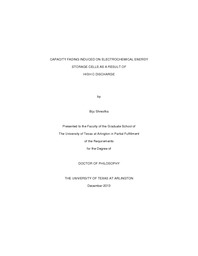
ATTENTION: The works hosted here are being migrated to a new repository that will consolidate resources, improve discoverability, and better show UTA's research impact on the global community. We will update authors as the migration progresses. Please see MavMatrix for more information.
Show simple item record
| dc.contributor.author | Shrestha, Biju | en_US |
| dc.date.accessioned | 2014-03-12T23:51:11Z | |
| dc.date.available | 2014-03-12T23:51:11Z | |
| dc.date.issued | 2014-03-12 | |
| dc.date.submitted | January 2013 | en_US |
| dc.identifier.other | DISS-12414 | en_US |
| dc.identifier.uri | http://hdl.handle.net/10106/24130 | |
| dc.description.abstract | A number of electrochemical energy storage devices have been developed and used widely to power portable electronic systems. Lithium-ion batteries are extremely popular for use in portable devices as a result of their high energy density, which is higher than almost all other similar technologies available. Despite their high energy density, most commercial off-the-shelf (COTS) cells are only modestly power dense, limiting them from being used to drive high power or pulsed power applications. Recently, improvements in the electrode structures and electrolytes have led to the development of lithium-ion batteries which have a higher combined power and energy density than ever before. Cells with power densities as high as 28 kW/kg have been developed with energy densities near 52 Wh/kg [8]. In addition to lithium-ion batteries, advanced electrochemical capacitors, such as electric double layer capacitors (EDLC's) and lithium-ion capacitors (LICs), have been developed with extremely high power densities making them a suitable candidate for use in high and pulsed power applications which do not require high energy density. There have been many previous research efforts aimed at understanding the aging of these devices when they are used at their nominal ratings. However, what is lacking is an understanding of how these cells age when they are used to source high currents in either pulsed or continuous modes of operation. This knowledge is critical as high rate currents must be sourced if these devices are to be used in applications such as hybrid electric vehicles, renewable energy platforms, and even high pulsed power applications. The research documented here is aimed at understanding the limitations of these types of devices and to understand their future potential for use in continuous and pulsed high current applications. A novel test stand has been constructed to characterize the performance of these types of devices when they are discharged at rates 10's to 100's of times their rated C values in a high frequency pulsed fashion. Three identical high power Nickel- Cobalt-Aluminum-Oxide (NCA) lithium-ion batteries have been cycled at nominal, high C pulsed, and high C continuous rates respectively in order to understand the impact high rate cycling has on the aging of these types of cells. In-situ diagnostics have been used as a means of comparison between the different experimental methods. | en_US |
| dc.description.sponsorship | Wetz Jr., David A. | en_US |
| dc.language.iso | en | en_US |
| dc.publisher | Electrical Engineering | en_US |
| dc.title | Capacity Fading Induced On Electrochemical Energy Storage Cells As A Result Of High C Discharge | en_US |
| dc.type | Ph.D. | en_US |
| dc.contributor.committeeChair | Wetz Jr., David A. | en_US |
| dc.degree.department | Electrical Engineering | en_US |
| dc.degree.discipline | Electrical Engineering | en_US |
| dc.degree.grantor | University of Texas at Arlington | en_US |
| dc.degree.level | doctoral | en_US |
| dc.degree.name | Ph.D. | en_US |
Files in this item
- Name:
- Shrestha_uta_2502D_12414.pdf
- Size:
- 5.624Mb
- Format:
- PDF
This item appears in the following Collection(s)
Show simple item record


